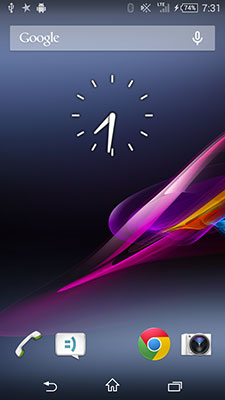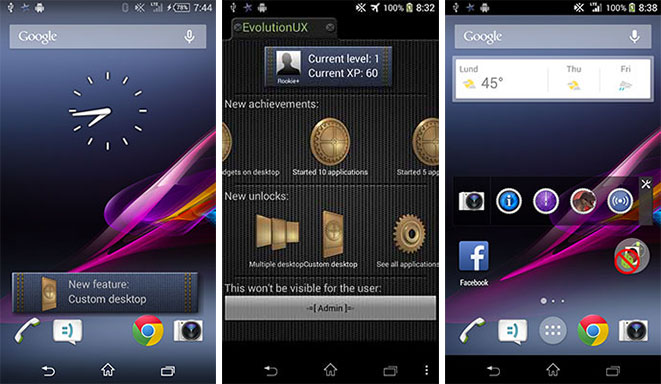Sony Working on "Gamified" Smartphone User Interface
Sony is experimenting with a cool user interface for smartphones.
Pál Szász, a Software Developer at Sony, recently updated Sony's blog with news that he's working on a new smartphone user interface (UI) called EvolutionUI.
The main goal of this project is to introduce gamification in the smartphone UI. Take an RPG for example. The player starts out with a stick, but eventually levels up to carry heavy armor, a shield and a sweeping sword. EvolutionUI does the same thing. It starts the user out with simple controls and builds layers of features as the end user becomes more experienced with the phone.
"In the EvolutionUI project, our main idea was to isolate advanced features and disable them at start," Szász writes. "For example, when a user starts an Android device for the first time, one desktop panel will probably be enough for a while. Also there is no need to be able to create folders or shortcuts for applications, since there won't be too many applications installed in the first couple of days. To have a lot of widgets on the desktop might also be confusing."
With EvolutionUI, the device owner starts out with only one Home screen displaying a clock widget and four core applications including phone, messages, Chrome and the camera. This screen is locked so the user doesn't delete an app by mistake. But as the user gets familiar with the basic functionality and learns how to use it, more features are unlocked and the phone gets more and more advanced.
So how does this approach work? If the device owners have started five applications after having started the phone, the user will get an "Achievement." These achievements will unlock features as a reward. "The features of the phone are unlocked step by step, in the same pace as the user learns how to use the phone. This makes the learning of the phone much easier, and a lot more fun as well," he says.
The main component of EvolutionUI is a core service called "EvolutionUIService," which keeps track of the phone usage. As an example, this service will record the number of applications that have been started. Each application that intends to use this service can publish its own set of experiences, features and achievements by using an XML resource.
"The EvolutionUIService will then aggregate all the features and achievements from all the applications and keep track of the user's overall progress," he writes. "It's up to all connected applications to notify the EvolutionUIService about actions performed by the user. Each application that is connected to the EvolutionUI concept then reports its experiences to the EvolutionUIService. The core service keeps count of these experiences."
Get Tom's Hardware's best news and in-depth reviews, straight to your inbox.
To read the whole blog post, head here. However, based on the information here, this user interface would be ideal for first-time Android users. Yet because this is an internal research project, don't expect this platform to be used by smartphone hardware any time soon. Still, it's a cool idea.

Kevin Parrish has over a decade of experience as a writer, editor, and product tester. His work focused on computer hardware, networking equipment, smartphones, tablets, gaming consoles, and other internet-connected devices. His work has appeared in Tom's Hardware, Tom's Guide, Maximum PC, Digital Trends, Android Authority, How-To Geek, Lifewire, and others.
-
Stimpack I don't know if I want to play the "Learn how to use your phone RPG", but I doubt this will see the light of day anyway.Reply -
takeshi7 They should just make an Xperia Play 2. hardware controls are the gamified user interface.Reply -
Morbus First thing you should do with any software or hardware, if you got any brains, is explore the options menu.Reply
If this crap has disabled features at the start.. Well, it's crap.
Also, this has nothing to do with gamification. -
TomsSound This ui.. sounds like a bad idea... Come on Sony.Reply
First off... most gamers already use smart phones and know how get around a phone. They won't want to level up to use the features.
Second.. people who don't know how to use android phones.. won't be looking at this phone. They will be taking advice from friends, family and phone store employees.. telling them to get either a Galaxy, iPhone, HTC or LG.
This phone ui.. really is just too gimmicky.
Phone manufacturers.. need to focus on some core elements.. battery life ,responsiveness, elegance and ruggedness.
Too many gimmicks... ie fingerprint readers, eye scrolling..
-
icemunk This is a good idea for old people, or technologically illiterate type people. For us that like to explore our devices, and take them to the limits; it seems stupidReply -
BanzaiWasabi How can Sony know in what order different people will need different functionalities? Imagine needing a specific feature that is deemed very advanced, and having to 'grind levels' to obtain it.Reply
If the interface is too confusing for a new user - there's something wrong with the interface, not with the user. They should spend their time redesigning their interface instead of finding a way to slowly introduce users to their chaos...
But then again, as Stimpack points out, this is unlikely to hit the shelves anyway, so... :-) -
BranFlake5 ReplyThey should just make an Xperia Play 2. hardware controls are the gamified user interface.
I don't think Sony would, only for the fact people would buy it instead of the Vita, therefore cannibalizing sales. Too bad, because It would make on hell of a Nvidia Shield contender. -
blackened144 ReplyThis is a good idea for old people, or technologically illiterate type people. For us that like to explore our devices, and take them to the limits; it seems stupid
I was thinking something similar.. I would never use it, but I would put my parents on something like this in a heartbeat. My mom had the iPad Air for 6 months before I visited and held down the home button to look at the list of running apps. I had to scroll through like 30 pages of apps. Something like this, I assume, would help educate users about these features, instead of leaving them in the dark complaining about why its not working right until they call the 7 year old next door.

